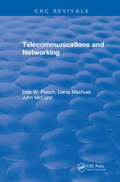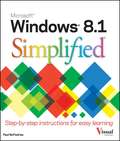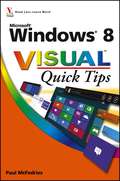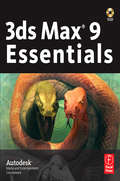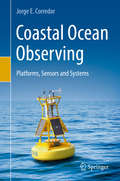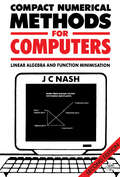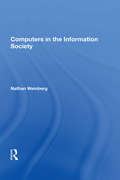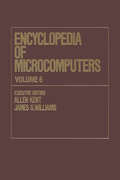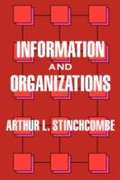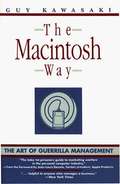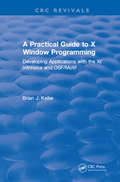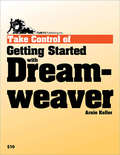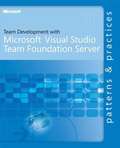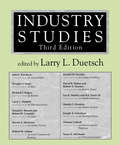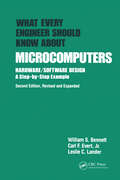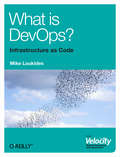- Table View
- List View
Telecommunications and Networking (Computer Science And Engineering Ser.)
by Udo W. PoochAs the dividing line between traditional computing science and telecommunications quickly becomes blurred or disappears in today's rapidly changing environment, there is an increasing need for computer professionals to possess knowledge of telecommunications principles. Telecommunications and Networking presents a comprehensive overview of the interaction and relationship between telecommunications and data processing. The book's early chapters cover basic telecommunications vocabulary, common nomenclature, telecommunications fundamentals, as well as the important relationships among coding, error detection and correction, and noise. Later chapters discuss such topics as switching, timing, topological structures, routing algorithms, and teleprocessing. Other topics covered in detail include specific concerns inherent to computer communications, such as protocols, error detection and correction, network monitoring and security, and system validation.System designers and programmers can no longer be effective simply by understanding the tradeoffs between hardware and software. Telecommunications and Networking provides both computing professionals and students the fundamental computer communications concepts necessary to function in today's computer industry.
Windows 8.1 Simplified
by Paul McfedriesThe easiest way for visual learners to get started with Windows 8The popular Simplified series makes visual learning easier than ever, and with more than 400,000 copies sold, previous Windows editions are among the bestselling Visual books. Using a Visual approach, this book covers the new features of Windows 8.1 and provides step-by-step instructions for readers who are entirely new to the subject. Inside, you'll discover tasks on topics such as: Windows basics, creating movies, sharing their computer, working with and managing files, browsing the web, and new ways to customize Windows to work for you. This book covers the new features of Windows 8.1, including: the interface and the new and improved Internet Explorer. Perfect for the absolute beginner, with easy-to-follow instructions and colorful illustrations that show what's happening on the screenCovers Windows basics, navigating the interface, creating accounts to share a computer, customizing Windows, and working with filesDemonstrates how to browse the web with the new version of Internet Explorer, how to use media features, and much moreThe bestselling Simplified series is designed to make it easy for visual learners to start using new technologies right awayWindows 8.1 Simplified will get you up and running in a friendly and comfortable environment in no time.
Windows 8 Visual Quick Tips
by Paul McfedriesEasy-in, easy-out format covers all the bells and whistles of Windows 8If you want to learn how to work smarter and faster in Microsoft's Windows 8 operating system, this easy-to-use, compact guide delivers the goods. Designed for visual learners, it features short explanations and full-color screen shots on almost every page, and it's packed with timesaving tips and helpful productivity tricks. From enhancing performance and managing digital content to setting up security and much more, this handy guide will help you get more out of Windows 8.Uses full-color screen shots and short, step-by-step instructions to help visual learners become more proficient with Windows 8Covers the basics as well as innovative ideas and tricks to help you get more done in less timeExplores customizing Windows 8, managing digital content, maintaining privacy and security, enhancing operating system performance, and moreFrom the basics to beyond, Windows 8 Visual Quick Tips will help you get everyday tasks done quickly and easily, and get more out of Windows 8.
Winning Pachinko
by Eric C. SedenskyPachinko, a game played by over 30 million Japanese, is synonymous with glaring lights, mind-rattling noise and smoke-choked parlors. To the uninitiated, the game's phenomenal popularity is nothing less than an enigma. The unofficial truth is that pachinko is one of Japan's biggest forms of gambling. For non-Japanese, the hush surrounding this money-making aspect has contributed to misunderstandings about the game. Now, with Winning Pachinko Eric Sedensky opens parlor doors to the English-speaking world and guides readers through the essentials of play - where to buy balls, how to select a machine, and most importantly, how and where to claim one's booty of cool cash. A glossary of pachinko terms, useful diagrams, and photographs accompany the text.
3ds Max 9 Essentials: Autodesk Media and Entertainment Courseware
by AutodeskBring 3D film effects to the big screen. Generate realistic characters for a top-selling game. Create rich and complex design visualization. Autodesk® 3ds Max® 9 lets you maximize your productivity and tackle challenging animation projects. And this book, developed by Autodesk insiders, lets you master the essential tools and techniques. Learn how to use 3ds Max 9 confidently in a production environment. Each chapter of this book has a series of theory lessons and one lab. The theory lessons introduce you to the functional areas of 3ds Max and explain these features with short simple examples. The lab demonstrates a practical application of the theory. Combined, each chapter delivers a sound understanding of the functions, features and principles behind 3ds Max 9, and shows you how to apply this knowledge to real-world situations.
Coastal Ocean Observing: Platforms, Sensors and Systems
by Jorge E. CorredorThis manual describes the wide range of electromechanical, electrochemical and electro-optical transducers at the heart of current field-deployable ocean observing instruments. Their modes of operation, precision and accuracy are discussed in detail. Observing platforms ranging from the traditional to the most recently developed are described, as are the challenges of integrating instrument suits to individual platforms. Technical approaches are discussed to address environmental constraints on instrument and platform operation such as power sources, corrosion, biofouling and mechanical abrasion. Particular attention is also given to data generated by the networks of observing platforms that are typically integrated into value-added data visualization products, including numerical simulations or models. Readers will learn about acceptable data formats and representative model products. The last section of the book is devoted to the challenges of planning, deploying and maintaining coastal ocean observing systems. Readers will discover practical applications of ocean observations in diverse fields including natural resource conservation, commerce and recreation, safety and security, and climate change resiliency and adaptation. This volume will appeal to ocean engineers, oceanographers, commercial and recreational ocean data users, observing systems operators, and advanced undergraduate and graduate students in the field of ocean observing.
Compact Numerical Methods for Computers: Linear Algebra and Function Minimisation
by John C. NashThis second edition of Compact Numerical Methods for Computers presents reliable yet compact algorithms for computational problems. As in the previous edition, the author considers specific mathematical problems of wide applicability, develops approaches to a solution and the consequent algorithm, and provides the program steps. He emphasizes usefu
Computer Applications for Business: Step-by-step Exercises and Applications
by Iris BlancComputer Applications for Business will introduce you to word processing, spreadsheet, database and desktop presentation concepts through sequential practice material. Most of the exercises relate to computers. Consequently, while you are doing the exercises, you are also learning about computers. The exercises proceed from basic to intermediate level. Since this book is generic, it may be used with any software or computer. There are five chapters in this book: 1. Word Processing, 2. Spreadsheet, 3. Database, 4. Integration, and 5. Desktop Publishing.
Computers In The Information Society
by Nathan WeinbergThis book examines the unfolding cultural and organizational impact of computers on human society. Through this analysis, it discusses the role of information technology in people's lives, interdependence between the society and its computer creations, and expectations in the information society.
Computers in Mathematics (Lecture Notes In Pure And Applied Mathematics Ser. #Vol. 113)
by V. ChudnovskyTalks from the International Conference on Computers and Mathematics held July 29-Aug. 1, 1986, Stanford U. Some are focused on the past and future roles of computers as a research tool in such areas as number theory, analysis, special functions, combinatorics, algebraic geometry, topology, physics,
Designing Instructional Strategies: The Prevention of Academic Learnig Problem
by Edward J. Kameenui Deborah C. SimmonsDesigning Instructional Strategies: The Prevention of Academic Learning Problems is about designing and delivering instruction to students with academic learning problems. These students are identified as learning disabled, mildly handicapped, or emotionally disturbed who receive services in special education or general education settings.
The Devouring Fungus (Tales of the Computer Age)
by Karla JenningsA must for anyone who's ever considered using a RAM chip as fertilizer of booting up a computer with a steel toe. Karla Jennings' humorous history of the computer age shows that no part of our world today escapes the computer's influence. Includes witty illustrations Garry Trudeau, Rich Tennant, and others.
Encyclopedia of Microcomputers: Volume 6 - Electronic Dictionaries in Machine Translation to Evaluation of Software: Microsoft Word Version 4.0 (Microcomputers Encyclopedia Ser.)
by Allen Kent James G. Williams"The Encyclopedia of Microcomputers serves as the ideal companion reference to the popular Encyclopedia of Computer Science and Technology. Now in its 10th year of publication, this timely reference work details the broad spectrum of microcomputer technology, including microcomputer history; explains and illustrates the use of microcomputers throughout academe, business, government, and society in general; and assesses the future impact of this rapidly changing technology."
Father, Son, and Company: My Life at IBM and Beyond
by Thomas J. Watson Jr. Peter PetreAlong with the story of a father and son, this is IBM's story too. It chronicles the management insights that shaped its course and its unique corporate culture, the style that made Thomas Watson Sr. one of America's most charismatic bosses, and the daring decisions by Thomas Watson Jr. that transformed IBM into the world's largest computing company. One of the greatest business-success stories of all time, "Father, Son & Co." is a moving lesson for fathers who dream for their children, as well as a testament to American ingenuity and values, told in a disarmingly frank and eloquent voice.
The Ghost Inside the Monitor
by Margaret J. Anderson[from the back cover] "Something weird is going on in Sarah's father's new computer store. When Sarah looks at her reflection in the monitor, the face she sees isn't hers! It belongs to a younger girl, named Pascale, whose tragic story mysteriously writes itself across Sarah's computer screen. Sarah is fascinated, and then haunted, by Pascale's tale--because the little girl's ghost has a very real grip on her. Pascale repeatedly propels Sarah back in time (where Sarah is forced to relive adventures from Pascale's life in frontier Oregon) in a desperate attempt to solve the century-old mystery of her disappearance. Can Sarah find a way to bring peace to Pascale's ghost? It's either that or risk being marooned in someone else's past, perhaps for good!"
Information and Organizations
by Arthur L. StinchcombeIn a mix of theoretical insights and anecdotal material, this book explores the ins and outs of organizations from both a macro and micro perspective that has long confronted business people and those interested in organizational theory.
The Macintosh Way
by Guy KawasakiThe Macintosh Way is the take-no-prisoners guide to guerrilla marketing warfare in the personal computer software industry, celebrating passion, competition, excellence, and hard work.
A Practical Guide To X Window Programming: Developing Applications with the XT Intrinsics and OSF/Motif
by Brian J. KellerA Practical Guide to X Window Programming is a basic guide that takes readers step by step through developing applications using X-Windows. The book covers the Xt Intrinsics portion of the X-Window system in detail and discusses the MIT Athena and OSF/Motif Widget Sets that are used in many of the examples. Topics covered include C programming fundamentals, text handling using X, fonts, event handling in Xt, extending the Widget Sets (building on Field Editor Widget), designing and constructing an application, building menus, printing help, OSF/Motif (including the window arranger) and interclient communication. Three extensive appendices are included: Widgets, Classing, and Exported Functions; Quick Xt Reference Guide (X11R4); and Quick Guide to OSF/Motif Widgets. Any applications designer interested in developing applications with Xt will find this book a valuable and enlightening resource.
Quantum Computer Science
by N. David Mermin"This book is an introduction to quantum computation, developing the basic elements of this new branch of computational theory without assuming any background in physics. It begins with an introduction to quantum theory from a computer-science perspective. It illustrates the quantum-computational approach with several elementary examples of quantum speed-up, before moving to the major applications: Shot's factoring algorithm, Grover's search algorithm, and quantum error corrections. "--BOOK JACKET.
Take Control of Getting Started with Dreamweaver
by Arnie KellerLearn fundamental Web design principles and become comfortable working in Dreamweaver's complex interface! Dreamweaver 8 is a great Web design tool for pros, but newcomers may be overwhelmed by its interface or want to know more about how to work creatively and intelligently in the program. Help is at hand in Take Control of Getting Started with Dreamweaver, which offers a detailed tutorial for making your first site in Dreamweaver. Author Arnie Keller, who teaches Web design at the University of Victoria, shows you how to style type the smart way with CSS, create a sophisticated page layout using layers, and design a template-based site with an interactive navigation bar. This book also breaks new ground by linking to video screenshots (check them out now!) that show you exactly what to do. Read this book to learn the answers to questions such as: How can I experiment with different type formats? Can I control exactly where text and graphics appear on my pages? What's the best way to make a navigation bar that will help people find their way around my site? I want all my pages to have the same header and footer - how do I set up a template that automatically takes care of these repeating elements? How do I transfer my site to a Web server from within Dreamweaver?
Team Development with Visual Studio® Team Foundation Server
by Microsoft CorporationThis guide shows you how to get the most out of Visual Studio 2005 Team Foundation Server to help improve the effectiveness of your team-based software development. Whether you are already using Team Foundation Server or adopting from scratch, you'll find guidance and insights you can tailor for your specific scenarios.
Uncertainty
by M. Granger Morgan Max HenrionThis volume, like its predecessors, reflects the cutting edge of research on the automation of reasoning under uncertainty. A more pragmatic emphasis is evident, for although some papers address fundamental issues, the majority address practical issues. Topics include the relations between alternative formalisms (including possibilistic reasoning), Dempster-Shafer belief functions, non-monotonic reasoning, Bayesian and decision theoretic schemes, and new inference techniques for belief nets. New techniques are applied to important problems in medicine, vision, robotics, and natural language understanding.
Urban Politics: New York Style
by J. Bellush Dick NetzerIn many respects, New York City is an unnatural wonder, quite unlike any other American city and also unlike megacities in other industrial countries. Its government and politics, its physical attributes-like the celebrated skyline and high population density-and many of its social characteristics-like the extraordinarily high percentage of the city's population that is foreign-born-are different. But New York City at the same time shares with other American cities an array of political and governmental institutions, practices, traditions, and pressures, ranging from the long dominance and then long decline in the role of party organizations in local government to the city's ultimate dependence on outside actors and forces to shape its political destiny.
What Every Engineer Should Know about Microcomputers: Hardware/Software Design: a Step-by-step Example, Second Edition,
by William S. Bennett Carl F. Evert Jr. Leslie C. LanderRevised and expanded guide demonstrates microcomputer usage by working through one simple design challenge and explaining its solution. This edition features the contributions of an Ada expert, demonstrates (in 14 new chapters) the development of a microcomputer system structured by this language.
What is DevOps?
by Mike LoukidesHave we entered the age of NoOps infrastructures? Hardly. Old-style system administrators may be disappearing in the face of automation and cloud computing, but operations have become more significant than ever. As this O'Reilly Radar Report explains, we're moving into a more complex arrangement known as "DevOps." Mike Loukides, O'Reilly's VP of Content Strategy, provides an incisive look into this new world of operations, where IT specialists are becoming part of the development team. In an environment with thousands of servers, these specialists now write the code that maintains the infrastructure. Even applications that run in the cloud have to be resilient and fault tolerant, need to be monitored, and must adjust to huge swings in load. That was underscored by Amazon's EBS outage last year. From the discussions at O'Reilly's Velocity Conference, it's evident that many operations specialists are quickly adapting to the DevOps reality. But as a whole, the industry has just scratched the surface. This report tells you why.
